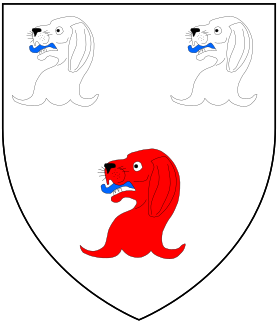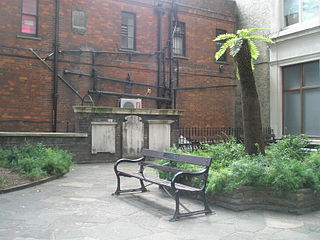
James Fiennes, 1st Baron Saye and Sele was an English soldier and politician. He was born at Herstmonceux, Sussex, the second son of Sir William Fiennes and his wife Elizabeth Batisford.

Sir Edmund Shaa or Shaw was a London goldsmith, Sheriff of London in 1475 and Lord Mayor of London in 1482. Shaa lent money to Edward IV and, as mayor, was extensively involved in the coronation of Edward IV's brother Richard III. He was later knighted and made a member of the Privy Council.
Capt. John Martin (c.1560—1632) was a Councilman of the Jamestown Colony in 1607. He was the proprietor of Martin's Brandon Plantation on the south bank of the James River. Located in modern-day Prince George County, Virginia and known as Lower Brandon Plantation, in the 21st century, his c. 1616 plantation is both a National Historic Landmark open to tours and one of America's oldest continuous farming operations.

Sir Charles Duncombe of Teddington, Middlesex and Barford, Wiltshire, was an English banker and Tory politician who sat in the English and British House of Commons between 1685 and 1711. He served as Lord Mayor of London from 1708 to 1709. He made a fortune in banking and was said to be worth £400,000 later in life, and the richest commoner in England on his death.
Robert Amadas was a London Goldsmith whose clients included King Henry VIII and his courtiers. He was Master of the King's Jewel House, and one of the Deputy Masters of the Mint.

St Peter, Westcheap, also called "St Peter Cheap", "St Peter at the Cross in Cheap", or "Ecclesia S. Petri de Wodestreet", was a parish and parish church of medieval origins in the City of London. The church stood at the south-west corner of Wood Street where it opens onto Cheapside, directly facing the old Cheapside Cross. In its heyday it was a familiar landmark where the City waits used to stand on the roof and play as the great processions went past. It was destroyed in the Great Fire of London in 1666, together with most of its surroundings, and was never rebuilt.
Sir Richard Martin was an English goldsmith and Master of the Mint who served as Sheriff and twice as Lord Mayor of the City of London during the reign of Elizabeth I.

Sir Martin Bowes was a very prominent and active civic dignitary of Tudor London whose career continued through the reigns of Henry VIII, Edward VI, Mary I and Elizabeth I. Born into the citizenry of York, Bowes was apprenticed in London and made his career at the Royal Mint, as a master-worker and under-treasurer, and personally implemented the debasement of English currency which became a fiscal imperative in the later reign of Henry.
John Browne, of London and Horton Kirby, Kent, was Warden of the Mint and MP for Aldborough.

John Lonyson or Lonison (1525–1582) was an English goldsmith and Master of the Mint in the reign of Elizabeth I.
Sir John Shaa or Shaw was a London goldsmith. He served as engraver and later joint Master of the Mint, and as Sheriff and Lord Mayor of London. While Lord Mayor he entertained ambassadors from Scotland, and was among those who welcomed Catherine of Aragon to England. He is mentioned in a poem by William Dunbar.
Sir William Browne served as Master of the Worshipful Company of Mercers from 1507 to 1514, and as alderman, auditor, Sheriff and Lord Mayor of London. He died in office on 3 June 1514 while serving his term as Lord Mayor.
Sir Francis Child (1642–1713), of Hollybush House, Fulham, Middlesex and the Marygold by Temple Bar, London, was an English banker and politician who sat in the English and British House of Commons between 1698 and 1713. He served as Lord Mayor of London for the year 1698 to 1699. The goldsmith's business which he built up from 1671 later became one of the first London banks, Child & Co.
Peter Perchard was a British goldsmith and merchant who served as Lord Mayor of London in 1804.
Gregory de Rokesley was an English goldsmith, Mayor of London and Warden of the Mint. He was originally from Rokesley in Kent and was a wealthy wool merchant and goldsmith. In 1263, 1265 and 1270, he served as Sheriff of London and then served as Lord Mayor of London for a total of 8 occasions from the years 1274 through to 1280 and again in the year 1284. In 1276 he was made Kings Chamberlain and acted in that capacity for two years. He was joint Warden of the Mint from 1279 to 1292.
Nicholas de Farndone was a 14th-century English goldsmith and politician who served four non-consecutive terms as Mayor of London.
Andrew Aubrey was an English merchant and politician, who served three terms as Lord Mayor of London during the reign of Edward III.
William Cromer was an English Sheriff and Lord Mayor of London and a Member of Parliament for the city.
Sir Drugo Barentyn, sometimes spelled as "Drew", "Dru", "Barentine" or "Barrington", was an English goldsmith and politician who served twice as Lord Mayor of London.
Adam Bamme was an English goldsmith and politician who served two non-consecutive terms as Lord Mayor of London in the 14th century.






